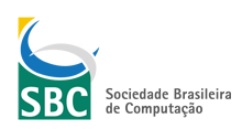Institutional Situatedness in Multi-Agent Systems
Resumo
Institutions regulating multi-agent systems are not autonomous. Their state changes as the result of facts occurring in the environment where agents act. The modelling of institutional dynamics allowing the institutional regulation based on environmental facts is not a trivial matter. Different institutional abstractions represent different social aspects, having different natures, semantics, life cycles, etc. This work reviews the institutional situatedness analysing how it is currently addressed. We propose a classification for the existing approaches and point some open issues to be tackled in such subject.
Referências
Aldewereld, H., Alvarez-Napagao, S., Dignum, F., and Vázquez-Salceda, J. (2009). Engineering Social Reality with Inheritance Relations. In Proc. 10th International Workshop on Engineering Societies in the Agents World X.
Artikis, A., Pitt, J., and Sergot, M. (2002). Animated specifications of computational societies. In Proc. 1st international joint conference on Autonomous agents and multiagent systems.
Boissier, O., Hübner, J. F., and Sichman, J. S. (2007). Organization Oriented Programming: From Closed to Open Organizations. In O’Hare, G. M. P., Ricci, A., O’Grady, M. J., and Dikenelli, O., editors, Engineering Societies in the Agents World VII, volume 4457 of LNCS, pages 86–105. Springer Berlin Heidelberg.
Brito, M. (2012). Uma linguagem para especificação da dinâmica dos fatos institucionais em sistemas multiagentes. Master’s thesis, Universidade Federal de Santa Catarina, Centro Tecnológico. Programa de Pós-Graduação em Engenharia de Automação e Sistemas.
Brito, M., Hübner, J. F., and Bordini, R. H. (2013). Programming institutional facts in multi-agent systems. In Aldewereld, H. and Sichman, J. S. a., editors, Coordination, Organizations, Institutions, and Norms in Agent Systems VIII, volume 7756 of LNCS, pages 158–173. Springer Berlin Heidelberg.
Campos, J., López-Sánchez, M., Rodríguez-Aguilar, J., and Esteva, M. (2009). Formalising Situatedness and Adaptation in Electronic Institutions. In Hübner, J., Matson, E., Boissier, O., and Dignum, V., editors, Coordination, Organizations, Institutions and Norms in Agent Systems IV, volume 5428 of LNCS, pages 126–139. Springer Berlin / Heidelberg.
Castelfranchi, C. (2000). Engineering social order. 1972:1–18.
Chesani, F., Mello, P., Montali, M., and Torroni, P. (2013). Representing and monitoring social commitments using the event calculus. Autonomous Agents and Multi-Agent Systems, 27(1):85–130.
Coutinho, L. R., Sichman, J. S., and Boissier, O. (2009). Handbook of Research on Multi-Agent Systems: Semantics and Dynamics of Organizational Models, chapter Modelling Dimensions for Agent Organizations. Information Science Reference.
Dastani, M., Grossi, D., Meyer, J.-J. C., and Tinnemeier, N. (2009). Knowledge Representation for Agents and Multi-Agent Systems. chapter Normative Multi-agent Programs and Their Logics, pages 16–31. Springer-Verlag, Berlin, Heidelberg.
Dastani, M., Tinnemeier, N., and Meyer, J.-J. (2008). A programming language for normative multi-agent systems, chapter XVI, pages 397–417. Information Science Reference, Hershey, PA, USA.
Dastani, M., Torre, L., and Yorke-Smith, N. (2013). Monitoring interaction in organisations. In Aldewereld, H. and Sichman, J. S., editors, Coordination, Organizations, Institutions, and Norms in Agent Systems VIII, volume 7756 of LNCS, pages 17–34. Springer Berlin Heidelberg.
Esteva, M., Rodríguez-Aguilar, J. A., Sierra, C., Garcia, P., and Arcos, J. L. (2001). On the Formal Specifications of Electronic Institutions. In Dignum, F. and Sierra, C., editors, AgentLink, volume 1991 of LNCS, pages 126–147. Springer.
Esteva, M., Rosell, B., Rodríguez-Aguilar, J. A., and Arcos, J. L. (2004). AMELI: An Agent-Based Middleware for Electronic Institutions. pages 236–243.
Fornara, N. and Colombetti, M. (2006). Specifying and Enforcing Norms in Artificial Institutions. In Dunin-Keplicz, B., Omicini, A., and Padget, J. A., editors, EUMAS, volume 223 of CEUR Workshop Proceedings. CEUR-WS.org.
Grossi, D., Aldewereld, H., Vázquez-Salceda, J., and Dignum, F. (2006a). Ontological aspects of the implementation of norms in agent-based electronic institutions. Computational & Mathematical Organization Theory, 12(2-3):251–275.
Grossi, D., Meyer, J.-J. C., and Dignum, F. (2006b). Counts-as: Classification or Constitution? An Answer Using Modal Logic. In Goble, L. and Meyer, J.-J. C., editors, DEON, volume 4048 of LNCS, pages 115–130. Springer.
Gutknecht, O. and Ferber, J. (2001). The madkit agent platform architecture. In Wagner, T. and Rana, O. F., editors, Infrastructure for Agents, Multi-Agent Systems, and Scalable Multi-Agent Systems, volume 1887 of Lecture Notes in Computer Science, pages 48–55. Springer Berlin Heidelberg.
Hübner, J. F., Boissier, O., Kitio, R., and Ricci, A. (2009). Instrumenting multi-agent organisations with organisational artifacts and agents. Autonomous Agents and Multi-Agent Systems, 20(3):369–400.
Hübner, J. F., Sichman, J. S., and Boissier, O. (2006). S - Moise+: A middleware for developing organised multi-agent systems. In Boissier, O., Padget, J., Dignum, V., Lindemann, G., Matson, E., Ossowski, S., Sichman, J., and Vázquez-Salceda, J., editors, Coordination, Organizations, Institutions, and Norms in Multi-Agent Systems, volume 3913 of Lecture Notes in Computer Science, pages 64–77. Springer Berlin Heidelberg.
Piunti, M. (2009). Designing and Programming Organizational Infrastructures for Agents situated in Artifact-based Environments. PhD thesis, Universit‘ di Bologna.
Piunti, M., Boissier, O., Hübner, J. F., and Ricci, A. (2010). Embodied organizations: a unifying perspective in programming agents, organizations and environments. In MALLOW.
Ricci, A., Piunti, M., and Viroli, M. (2011). Environment programming in multi-agent systems: an artifact-based perspective. Autonomous Agents and Multi-Agent Systems, 23(2):158–192.
Searle, J. (1995). The Construction of Social Reality. Free Press.
Searle, J. (2009). Making the Social World:The Structure of Human Civilization. Oxford University Press.
Tinnemeier, N., Dastani, M., and Meyer, J.-J. In Proc. of 8th International Conference on Autonomous Agents and Multiagent Systems - Volume 1, pages 121–128, Richland, SC.
Tinnemeier, N., Dastani, M., and Meyer, J.-J. In Proc. of 9th International Conference on Autonomous Agents and Multiagent Systems: volume 1 - Volume 1, pages 957–964, Richland, SC.
Tinnemeier, N. A. M., Dastani, M. M., Meyer, J.-J. C., and van der Torre, L. (2009). Programming Normative Artifacts with Declarative Obligations and Prohibitions. Web Intelligence and Intelligent Agent Technology, IEEE/WIC/ACM International Conference on, 2:145–152.



